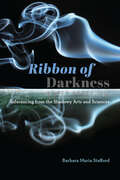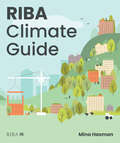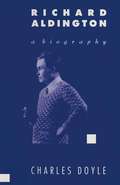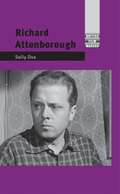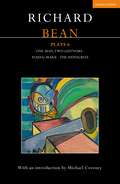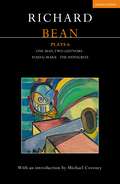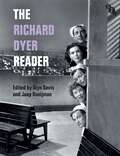- Table View
- List View
Ribbon of Darkness: Inferencing from the Shadowy Arts and Sciences
by Barbara Maria StaffordOver the course of her career, Barbara Stafford has established herself the preeminent scholar of the intersections of the arts and sciences, articulating new theories and methods for understanding the sublime, the mysterious, the inscrutable. Omnivorous in her research, she has published work that embraces neuroscience and philosophy, biology and culture, pinpointing connections among each discipline’s parallel concerns. Ribbon of Darkness is a monument to the scope of her work and the range of her intellect. At times associative, but always incisive, the essays in this new volume take on a distinctly contemporary purpose: to uncover the ethical force and moral aspects of overlapping scientific and creative inquiries. This shared territory, Stafford argues, offers important insights into—and clarifications of—current dilemmas about personhood, the supposedly menial nature of manual skill, the questionable borderlands of gene editing, the potentially refining value of dualism, and the limits of a materialist worldview. Stafford organizes these essays around three concepts that structure the book: inscrutability, ineffability, and intuitability. All three, she explains, allow us to examine how both the arts and the sciences imaginatively infer meaning from the “veiled behavior of matter,” bringing these historically divided subjects into a shared intellectual inquiry and imbuing them with an ethical urgency. A vanguard work at the intersection of the arts and sciences, this book will be sure to guide readers from either realm into unfamiliar yet undeniably fertile territory.
Ribbon of Darkness: Inferencing from the Shadowy Arts and Sciences
by Barbara Maria StaffordOver the course of her career, Barbara Stafford has established herself the preeminent scholar of the intersections of the arts and sciences, articulating new theories and methods for understanding the sublime, the mysterious, the inscrutable. Omnivorous in her research, she has published work that embraces neuroscience and philosophy, biology and culture, pinpointing connections among each discipline’s parallel concerns. Ribbon of Darkness is a monument to the scope of her work and the range of her intellect. At times associative, but always incisive, the essays in this new volume take on a distinctly contemporary purpose: to uncover the ethical force and moral aspects of overlapping scientific and creative inquiries. This shared territory, Stafford argues, offers important insights into—and clarifications of—current dilemmas about personhood, the supposedly menial nature of manual skill, the questionable borderlands of gene editing, the potentially refining value of dualism, and the limits of a materialist worldview. Stafford organizes these essays around three concepts that structure the book: inscrutability, ineffability, and intuitability. All three, she explains, allow us to examine how both the arts and the sciences imaginatively infer meaning from the “veiled behavior of matter,” bringing these historically divided subjects into a shared intellectual inquiry and imbuing them with an ethical urgency. A vanguard work at the intersection of the arts and sciences, this book will be sure to guide readers from either realm into unfamiliar yet undeniably fertile territory.
Ribbon of Darkness: Inferencing from the Shadowy Arts and Sciences
by Barbara Maria StaffordOver the course of her career, Barbara Stafford has established herself the preeminent scholar of the intersections of the arts and sciences, articulating new theories and methods for understanding the sublime, the mysterious, the inscrutable. Omnivorous in her research, she has published work that embraces neuroscience and philosophy, biology and culture, pinpointing connections among each discipline’s parallel concerns. Ribbon of Darkness is a monument to the scope of her work and the range of her intellect. At times associative, but always incisive, the essays in this new volume take on a distinctly contemporary purpose: to uncover the ethical force and moral aspects of overlapping scientific and creative inquiries. This shared territory, Stafford argues, offers important insights into—and clarifications of—current dilemmas about personhood, the supposedly menial nature of manual skill, the questionable borderlands of gene editing, the potentially refining value of dualism, and the limits of a materialist worldview. Stafford organizes these essays around three concepts that structure the book: inscrutability, ineffability, and intuitability. All three, she explains, allow us to examine how both the arts and the sciences imaginatively infer meaning from the “veiled behavior of matter,” bringing these historically divided subjects into a shared intellectual inquiry and imbuing them with an ethical urgency. A vanguard work at the intersection of the arts and sciences, this book will be sure to guide readers from either realm into unfamiliar yet undeniably fertile territory.
Ribbon of Darkness: Inferencing from the Shadowy Arts and Sciences
by Barbara Maria StaffordOver the course of her career, Barbara Stafford has established herself the preeminent scholar of the intersections of the arts and sciences, articulating new theories and methods for understanding the sublime, the mysterious, the inscrutable. Omnivorous in her research, she has published work that embraces neuroscience and philosophy, biology and culture, pinpointing connections among each discipline’s parallel concerns. Ribbon of Darkness is a monument to the scope of her work and the range of her intellect. At times associative, but always incisive, the essays in this new volume take on a distinctly contemporary purpose: to uncover the ethical force and moral aspects of overlapping scientific and creative inquiries. This shared territory, Stafford argues, offers important insights into—and clarifications of—current dilemmas about personhood, the supposedly menial nature of manual skill, the questionable borderlands of gene editing, the potentially refining value of dualism, and the limits of a materialist worldview. Stafford organizes these essays around three concepts that structure the book: inscrutability, ineffability, and intuitability. All three, she explains, allow us to examine how both the arts and the sciences imaginatively infer meaning from the “veiled behavior of matter,” bringing these historically divided subjects into a shared intellectual inquiry and imbuing them with an ethical urgency. A vanguard work at the intersection of the arts and sciences, this book will be sure to guide readers from either realm into unfamiliar yet undeniably fertile territory.
RIBA Climate Guide
by Mina HasmanClimate change is a threat to humankind, which requires immediate action. The built environment has a vital role to play in responding to the climate emergency. There is a pressing need for architects to acquire the requisite skills and knowledge to design buildings that deliver sustainable outcomes, meeting the RIBA 2030 Climate Challenge and mandatory competence in climate literacy. Equipping you with the key information that built environment professionals require to halt climate change and mitigate its impacts in your day-to-day work, this book is organised around six overarching topics: 1. Human Factors 2.Circular Economy 3.Energy and Carbon 4.Water 5.Ecology and Biodiversity 6.Connectivity and Transport Featuring images and original illustrations, each themed section will guide you through fundamental elements and competencies for creating a sustainable design and delivery framework that can be implemented by you in your practice. Contextualising the climate emergency within the built environment landscape, the guide maps out the essential background knowledge around climate science, international agreements, legislations, commitments and roadmaps. A collection of short, building- and urban-scale case studies present key takeaways, illustrating real-life applications of design strategies and industry-wide tools, as well as standards that are deployed in climate-conscious built environments all around the world.
RIBA Climate Guide
by Mina HasmanClimate change is a threat to humankind, which requires immediate action. The built environment has a vital role to play in responding to the climate emergency. There is a pressing need for architects to acquire the requisite skills and knowledge to design buildings that deliver sustainable outcomes, meeting the RIBA 2030 Climate Challenge and mandatory competence in climate literacy. Equipping you with the key information that built environment professionals require to halt climate change and mitigate its impacts in your day-to-day work, this book is organised around six overarching topics: 1. Human Factors 2.Circular Economy 3.Energy and Carbon 4.Water 5.Ecology and Biodiversity 6.Connectivity and Transport Featuring images and original illustrations, each themed section will guide you through fundamental elements and competencies for creating a sustainable design and delivery framework that can be implemented by you in your practice. Contextualising the climate emergency within the built environment landscape, the guide maps out the essential background knowledge around climate science, international agreements, legislations, commitments and roadmaps. A collection of short, building- and urban-scale case studies present key takeaways, illustrating real-life applications of design strategies and industry-wide tools, as well as standards that are deployed in climate-conscious built environments all around the world.
RIBA Conservation Guide
by David McDonald Marion Barter Andrew Shepherd Anna JoyntThis is an essential guide for those taking either the RIBA Conservation Register Course or another building conservation course. Taking as its starting point the ICOMOS Education and Training Guidelines, the internationally-recognised set of criteria, this book explores everything you need to know when undertaking projects that involve architectural conservation. This is the only book that deals systematically with the ICOMOS Guidelines, written by RIBA course tutors, bringing their extensive expertise to the table, with their varied and practical experience in the public, private and academic sectors. With guidance that can applied both in the UK and internationally, and covering the essential aspects of climate change and retrofit, this is a must-have handbook.
RIBA Conservation Guide
by David McDonald Marion Barter Andrew Shepherd Anna JoyntThis is an essential guide for those taking either the RIBA Conservation Register Course or another building conservation course. Taking as its starting point the ICOMOS Education and Training Guidelines, the internationally-recognised set of criteria, this book explores everything you need to know when undertaking projects that involve architectural conservation. This is the only book that deals systematically with the ICOMOS Guidelines, written by RIBA course tutors, bringing their extensive expertise to the table, with their varied and practical experience in the public, private and academic sectors. With guidance that can applied both in the UK and internationally, and covering the essential aspects of climate change and retrofit, this is a must-have handbook.
RIBA Ethical Practice Guide
by Carys Rowlands Alasdair Ben DixonEthical practice distinguishes an RIBA chartered architect from other design professionals. The RIBA Code of Professional Conduct requires practitioners to uphold high standards, while encouraging and empowering them to reflect critically and to continually strive to improve. The Grenfell Tower tragedy was a significant reminder of the ethical responsibilities of the architect, and the importance of ethical decision-making. By making ethical practice one of its mandatory competences, the RIBA has made it a requirement that students and professionals develop a fundamental level of awareness and understanding of ethics. This guide is designed to improve industry’s grasp of ethical decision-making as it relates to the wider world, society, clients, the workplace, the profession, and the individual. Each chapter introduces an ethical duty, setting out the relevant legal, regulatory and professional context before exploring the detailed subject matter and key principles. It includes an ethical dilemma for each duty and views and experiences from inside the profession. Delving into issues of equity, diversity and inclusion, social value, wellbeing and integrity, it does not seek our ‘right’ or ‘wrong’ answers. Rather it encourages reflection on different interests, consequences and considerations, in order to reach a considered and balanced position. While ethical practice is invaluable in itself, it is also vital for establishing trust with clients, improving transparency, enhancing reputation, attracting and retaining high-quality staff, avoiding disputes and for a high-level of accountability that benefits the entire industry, and society more broadly.
RIBA Ethical Practice Guide
by Carys Rowlands Alasdair Ben DixonEthical practice distinguishes an RIBA chartered architect from other design professionals. The RIBA Code of Professional Conduct requires practitioners to uphold high standards, while encouraging and empowering them to reflect critically and to continually strive to improve. The Grenfell Tower tragedy was a significant reminder of the ethical responsibilities of the architect, and the importance of ethical decision-making. By making ethical practice one of its mandatory competences, the RIBA has made it a requirement that students and professionals develop a fundamental level of awareness and understanding of ethics. This guide is designed to improve industry’s grasp of ethical decision-making as it relates to the wider world, society, clients, the workplace, the profession, and the individual. Each chapter introduces an ethical duty, setting out the relevant legal, regulatory and professional context before exploring the detailed subject matter and key principles. It includes an ethical dilemma for each duty and views and experiences from inside the profession. Delving into issues of equity, diversity and inclusion, social value, wellbeing and integrity, it does not seek our ‘right’ or ‘wrong’ answers. Rather it encourages reflection on different interests, consequences and considerations, in order to reach a considered and balanced position. While ethical practice is invaluable in itself, it is also vital for establishing trust with clients, improving transparency, enhancing reputation, attracting and retaining high-quality staff, avoiding disputes and for a high-level of accountability that benefits the entire industry, and society more broadly.
RIBA Health and Safety Guide
by Dieter Bentley-GockmannTo ensure chartered architects are reaching a high standard of health and safety knowledge and the life safety of building users, the RIBA has introduced an online test based on a comprehensive curriculum to test for competency. This guide is designed to improve industry understanding of issues in accordance with CDM Regulations and prepare architects for the health and safety test. It provides practitioners with the required knowledge regarding site safety, hazards and design risk management to discharge their professional services and legal duties competently and safely. The 2nd edition features an update to the content relating to design risk management and statue to reflect the changes proposed by the Act and the Regulations, as well as a review of the relationship between these and the existing regime under the CDM Regulations. It includes a new chapter that sets out some of the detail of duties under the Act and the Regulations, including practical examples of how designer/architects might discharge their duties as designers and lead designers, considering how it compares to existing duties under the CDM Regulations.
RIBA Health and Safety Guide
by Dieter Bentley-GockmannTo ensure chartered architects are reaching a high standard of health and safety knowledge and the life safety of building users, the RIBA has introduced an online test based on a comprehensive curriculum to test for competency. This guide is designed to improve industry understanding of issues in accordance with CDM Regulations and prepare architects for the health and safety test. It provides practitioners with the required knowledge regarding site safety, hazards and design risk management to discharge their professional services and legal duties competently and safely. The 2nd edition features an update to the content relating to design risk management and statue to reflect the changes proposed by the Act and the Regulations, as well as a review of the relationship between these and the existing regime under the CDM Regulations. It includes a new chapter that sets out some of the detail of duties under the Act and the Regulations, including practical examples of how designer/architects might discharge their duties as designers and lead designers, considering how it compares to existing duties under the CDM Regulations.
RIBA Health and Safety Guide
by RibaTo ensure chartered architects are reaching a higher standard of knowledge in health and safety and the life safety of building users, the RIBA will be introducing an online test based on a comprehensive curriculum for all members to demonstrate their competence. This guide is designed to improve the safety of practitioners on site and their understanding and application of health and safety processes to create buildings that are safe to build, operate and use. It will help prepare architects for the forthcoming RIBA health and safety test, providing practitioners with the guidance they require regarding site safety, both before and during construction, significant hazards and design risk management to discharge their professional services and legal duties competently and safely.
RIBA Health and Safety Guide
by RibaTo ensure chartered architects are reaching a higher standard of knowledge in health and safety and the life safety of building users, the RIBA will be introducing an online test based on a comprehensive curriculum for all members to demonstrate their competence. This guide is designed to improve the safety of practitioners on site and their understanding and application of health and safety processes to create buildings that are safe to build, operate and use. It will help prepare architects for the forthcoming RIBA health and safety test, providing practitioners with the guidance they require regarding site safety, both before and during construction, significant hazards and design risk management to discharge their professional services and legal duties competently and safely.
RIBA Job Book
by Nigel OstimeThe RIBA Job Book is the Royal Institute of British Architects’ long-established and recognised standard reference for running construction projects. This major new update fully reflects the new RIBA Plan of Work 2013 and contemporary working practice. It embraces themes of collaboration within the project team, better briefing, advances in information technology and BIM, and the continued importance of sustainability including valuable detail on a range of ‘cradle to grave’ processes in a building project. Applicable to all forms of procurement and to all sizes and types of project, the RIBA Job Book provides a systematic operational framework that is comprehensive in scope and easy-to-follow, and which examines step-by-step the key obligations of the architect or lead consultant. Setting out all the actions to be undertaken throughout a project, it includes invaluable checklists, notes and practical guidance.
RIBA Job Book
by Nigel OstimeThe RIBA Job Book is the Royal Institute of British Architects' long-established and recognised standard reference for running architectural projects and administering construction contracts. This new edition fully reflects the RIBA Plan of Work 2019 and contemporary working practice, providing a systematic operational framework that can be applied to all types of building project and forms of procurement. Comprehensive in scope and logically laid out, it embraces the theme of collaboration within the project team, and addresses post-occupancy evaluation, modern methods of construction and sustainability, among others. Setting out the actions to be undertaken throughout a project, it examines step-by-step the key obligations of the architect or project lead and includes invaluable checklists.
RIBA Job Book
by Nigel OstimeThe RIBA Job Book is the Royal Institute of British Architects' long-established and recognised standard reference for running architectural projects and administering construction contracts. This new edition fully reflects the RIBA Plan of Work 2019 and contemporary working practice, providing a systematic operational framework that can be applied to all types of building project and forms of procurement. Comprehensive in scope and logically laid out, it embraces the theme of collaboration within the project team, and addresses post-occupancy evaluation, modern methods of construction and sustainability, among others. Setting out the actions to be undertaken throughout a project, it examines step-by-step the key obligations of the architect or project lead and includes invaluable checklists.
RIBA Principal Designer's Guide
by Dieter Bentley-GockmannThe RIBA Principal Designer Guide, a companion guide to the RIBA Health and Safety Guide, provides architects with an essential understanding of the Principal Designer duties under the Construction (Design and Management) Regulations and Building Safety Act Dutyholder Regulations. To ensure chartered architects are reaching a high standard of knowledge, the RIBA has introduced an online test based on a comprehensive curriculum to test for competency. The must-have content considers details of the relevant statutory duties, guidance regarding the implications of those duties for project delivery and examples of documents, templates and schedules that Principal Designers could use to manage, track and demonstrate compliance with the duties. This guide also includes guidance on the competence requirements for Principal Designers with content mapped against BSI Flex 8670 and PAS 8671 that enables readers to demonstrate their competence.
RIBA Principal Designer's Guide
by Dieter Bentley-GockmannThe RIBA Principal Designer Guide, a companion guide to the RIBA Health and Safety Guide, provides architects with an essential understanding of the Principal Designer duties under the Construction (Design and Management) Regulations and Building Safety Act Dutyholder Regulations. To ensure chartered architects are reaching a high standard of knowledge, the RIBA has introduced an online test based on a comprehensive curriculum to test for competency. The must-have content considers details of the relevant statutory duties, guidance regarding the implications of those duties for project delivery and examples of documents, templates and schedules that Principal Designers could use to manage, track and demonstrate compliance with the duties. This guide also includes guidance on the competence requirements for Principal Designers with content mapped against BSI Flex 8670 and PAS 8671 that enables readers to demonstrate their competence.
Richard Aldington: A Biography
by Charles DoyleThis is the first biography of Richard Aldington, contemporary and friend of Ezra Pound, D.H. Lawrence and T.S. Eliot and notable as a poet, translator, editor, novelist, biographer and significant member of the Modernist era. A critical appraisal of his major writings is included.
Richard Attenborough (British Film-Makers)
by Sally DuxRichard Attenborough’s film career has stretched across seven decades; surprisingly, Sally Dux’s book is the first detailed scholarly analysis of his work as a filmmaker. Concentrating on his work behind the camera, she explores his initial role as a producer, including his partnerships with Bryan Forbes in Beaver Films (1959–64) and with Allied Film Makers (1960–64). As we know, Attenborough went on to direct twelve films, many of which achieved great acclaim, most notably Gandhi, which won eight Academy Awards in 1982Attenborough is most renowned for his biographical films including Young Winston, Cry Freedom, Chaplin and Shadowlands, which helped to establish the genre within British cinema. Although his work has often attracted controversy, particularly regarding the representation of individuals and historical events, his films are noted for extracting acclaimed performances from unknown actors such as Ben Kingsley (Gandhi), while maintaining his moral and thematic concerns.
Richard Attenborough (British Film-Makers)
by Sally DuxRichard Attenborough’s film career has stretched across seven decades; surprisingly, Sally Dux’s book is the first detailed scholarly analysis of his work as a filmmaker. Concentrating on his work behind the camera, she explores his initial role as a producer, including his partnerships with Bryan Forbes in Beaver Films (1959–64) and with Allied Film Makers (1960–64). As we know, Attenborough went on to direct twelve films, many of which achieved great acclaim, most notably Gandhi, which won eight Academy Awards in 1982Attenborough is most renowned for his biographical films including Young Winston, Cry Freedom, Chaplin and Shadowlands, which helped to establish the genre within British cinema. Although his work has often attracted controversy, particularly regarding the representation of individuals and historical events, his films are noted for extracting acclaimed performances from unknown actors such as Ben Kingsley (Gandhi), while maintaining his moral and thematic concerns.
Richard Bean Plays 6: One Man, Two Guvnors; Young Marx; The Hypocrite (Contemporary Dramatists)
by Richard BeanThe sixth collection of plays from award-winning playwright Richard Bean, including the world-conquering hit One Man, Two Guvnors, as well as Young Marx, his riotous take on Karl Marx's life in London, which launched London's new Bridge Theatre and The Hypocrite, a historical-farcical romp that lit up Hull's year as City of Culture.One Man, Two GuvnorsBased on Carlo Goldoni's classic Italian comedy The Servant of Two Masters, sex, food and money are high on the agenda.Winner of the both 2011 Evening Standard Theatre Best New Play & Critic's Circle Best New Play awards.Young MarxCreditors, spies, rival revolutionary factions and prospective seducers of his beautiful wife all circle like vultures. His writing blocked, his marriage dying, his friend Engels in despair at his wasted genius, his only hope is a job on the railway. But there's still no one in the capital who can show you a better night on the piss than Karl Heinrich Marx.The HypocriteApril 1642. Sir John Hotham, Governor of Hull, is charged by Parliament to secure the arsenal at Hull and deny entry to King Charles I. If only it were that simple. With a Royalist siege outside the city walls and the rebellion of the mob within, Civil War seems inevitable and losing his head more than probable.
Richard Bean Plays 6: One Man, Two Guvnors; Young Marx; The Hypocrite (Contemporary Dramatists)
by Richard BeanThe sixth collection of plays from award-winning playwright Richard Bean, including the world-conquering hit One Man, Two Guvnors, as well as Young Marx, his riotous take on Karl Marx's life in London, which launched London's new Bridge Theatre and The Hypocrite, a historical-farcical romp that lit up Hull's year as City of Culture.One Man, Two GuvnorsBased on Carlo Goldoni's classic Italian comedy The Servant of Two Masters, sex, food and money are high on the agenda.Winner of the both 2011 Evening Standard Theatre Best New Play & Critic's Circle Best New Play awards.Young MarxCreditors, spies, rival revolutionary factions and prospective seducers of his beautiful wife all circle like vultures. His writing blocked, his marriage dying, his friend Engels in despair at his wasted genius, his only hope is a job on the railway. But there's still no one in the capital who can show you a better night on the piss than Karl Heinrich Marx.The HypocriteApril 1642. Sir John Hotham, Governor of Hull, is charged by Parliament to secure the arsenal at Hull and deny entry to King Charles I. If only it were that simple. With a Royalist siege outside the city walls and the rebellion of the mob within, Civil War seems inevitable and losing his head more than probable.
The Richard Dyer Reader
by Glyn Davis Jaap KooijmanRichard Dyer is a foundational figure for the critical study of cinema and popular culture. Across a career spanning five decades, he has made path breaking contributions to our understanding of stardom and celebrity, gay and queer politics and cultural history, film music, race and whiteness and the pleasures of popular entertainment. The Richard Dyer Reader brings together for the first time key writings by this vital and influential figure, many of which are not otherwise available. The anthology guides readers through Dyer's prolific and rich output through six thematic selections of essays and extracts, each centred on a key theme in Dyer's work: stardom and the image; entertainment and ideology; gay politics and representation; whiteness; the pleasures of popular entertainment, and textual analysis. A seventh section comprises a selection of interviews conducted across the span of his career, as well as a new interview with editors Glyn Davis and Jaap Kooijman. The book will provide an introduction for those new to Dyer's writings, as well as offering a fresh perspective for readers with a more comprehensive knowledge of his work. The collection includes archival and recent pieces of writing never previously anthologised, newly commissioned essays, a substantial introduction to Dyer's life and work and framing introduction to each section.
